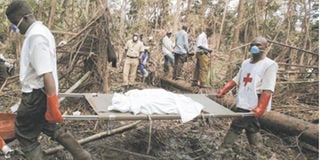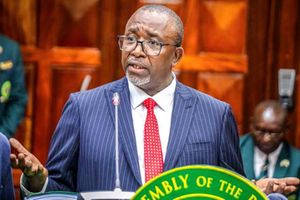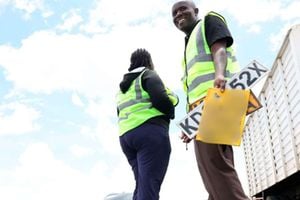Dead in 102 seconds: Revisiting tragic KQ crash in Douala

Red Cross workers carry body parts from the scene of the KQ plane crash in a swampy area 23 km east of the city of Douala.
What you need to know:
- Sixteen years ago, the country woke to the news that a Kenya Airways flight had disappeared after take-off in Cameroon. Two days later, the wreckage of the flight was discovered. Everyone on board, passengers and crew, were confirmed dead.
On the night of Friday May 5, 2007, heavy rains and thunder struck Douala city in Cameroon. Three flights scheduled to depart from Douala International Airport from 11pm were delayed—Kenya Airways flight KQ 507 was among them.
However, after one hour, the KQ flight took off, ascending into the pitch-dark stormy skies. Unfortunately, after only 102 seconds, the aircraft, a Boeing 738-800, crashed into a mangrove forest killing all 114 people on board.
It is now 16 years since the crash.
The Nationhas now gone back to the case, poring through dozens of pages of investigations reports, talking to witnesses, former staff of the airliner and journalists who covered the crash to paint a picture of how it happened and why.
The technical investigation report from the Cameroon Civil Aviation Authority provides answers to some of the questions, fingering the pilot, weather and breakdown of communication at the cockpit for the crash.
Released on April 28, 2010, the report notes that the pilot took off without authorisation from air traffic control, and that “there was a fallout in the cockpit whereby the captain and first officer were not working as a team and the first officer did not call out lapses in piloting”.
“The crew took off in full awareness of the prevailing meteorological condition, air traffic control did not broadcast latest weather reports to KQ 507, and the controller at the tower used French language to transmit a special weather report indicating much worsening condition following a request that was also done in French by the subject carrier, implying KQ 507 unlikely understood the severity of it,” the report states.
Further, it notes, at 1,000 feet climbing, the pilot released flight controls for 55 seconds without having engaged the auto pilot command, meaning that the plane was flying without input from the pilots or autopilot.
Pilot error was singled out as the main cause of the crash. A background check conducted against the captain revealed that he had some red flags in his history and poor cockpit skills.
The report states that as the bank angle (in basic terms a turning angle) of the airplane increased continuously by itself up to 34 degrees, the captain appeared unaware. Just before the warning sounds, the captain grabbed the controls, appearing confused, he made erratic corrections, increasing the bank angle to 50 degrees.
That is when the auto pilot was engaged and the inclination tended to stabilise. However, the pilot resumed controls and the bank angle increased towards 70 degrees. It was at that juncture that captain screamed “we are crashing” and the first officer responded in affirmative.
A prolonged right rudder input brought the bank angle to beyond 90 degrees and the aircraft went into a dive. The first officer frantically called out to the captain to level the wings by the right, then quickly corrected and insisted “left, left, left captain”. The bank angle was reduced to 70 degrees, but it was too late—the flight crashed inside a mangrove forest 5.42 kilometres from the airport.
The Emergency Locator Transmitter broke up on impact and therefore no useful signal was emitted to assist in locating the plane after the accident.
According to procedure, when the captain called for auto pilot to be engaged, the first officer should have pushed the appropriate button and responded by saying auto pilot engaged. But it looks like the first officer concentrated on inputting the route around the heavy storm and failed to engage the auto pilot. The captain, on the other hand, assumed it had been engaged and released the controls.
On the falling out between the 52-year-old captain and the 23-year-old first officer, the investigation team zeroed in on the cockpit voice recorder. The recording of the first leg from Abidjan to Douala revealed why the first officer remained silent.
The captain was heard screaming at the first officer asking “what was wrong with you? And when the officer sought clarification whether he had told him to rise to 1,400 feet, the captain retorted ... ‘Yes, don’t be stupid, write it down if you can’t remember’ and adding, “What’s wrong with you, did you not hear the instructions?”
With that tongue lashing, the first officer shut down, only engaging the captain sparingly.

The beginning
At 10.33pm KQ 507 made its first contact with the air traffic controller, requesting for start-up data which was transmitted at 11.20pm and KQ 507 requested clearance, which was granted. But, at 11.37pm, the crew cancelled start-up to wait for the weather to improve.
At 11.54pm the captain asked the first officer to request taxi clearance. The officer appeared surprised at the speed at which instructions were being issued—he told him to try and keep up.
The captain checked the storm position using the aircraft’s weather radar and figured the route around the storm, informing the control tower that after departure he would maintain heading left, but the first officer whispered “to the right”, forcing the captain to correct by saying “sorry to the right”. Seemingly, the captain’s mind was focused on how he would navigate around the storm.
At 12.06am, the aircraft took off without take-off clearance from the control tower, which is a major procedural breach.
The ill-fated flight was to have two legs—from Abidjan in Ivory Coast via Douala before landing at its final destination, Nairobi. Majority of the passengers on board were to connect flights upon touching down at Jomo Kenyatta International Airport.
On Friday May 4, 2007 at 6.30pm, the flight departed Félix-Houphouët-Boigny International Airport in Abidjan with 55 passengers and safely landed at Douala International Airport at 10. 01pm for a scheduled stopover. A total of 38 passengers disembarked while 91 new passengers boarded. The flight was expected to land in Nairobi on Saturday 6.15am
Immediately the plane departed from Douala Airport, its signal was lost and remained unnoticed until the Nairobi control tower called Douala to establish whether it had left.
Crisis
Mr Mike Okwiri, who was KQ’s spokesman at the time, says the signal was raised by the operation team three to four hours later. Kenya airways top brass hurriedly assembled at its Embakasi headquarters that morning at 5am where a command centre had been set up. A crisis of monumental proportion had struck.
“Initially, people took time to acclimatise and digest the news then the process of communication with people in Douala started. Communication was a challenge because Douala is not like Nairobi in terms of communication,” said Mr Okwiri.
The first official announcement was made by then KQ chief executive officer Titus Naikuni that Saturday morning. When he appeared before cameras, one could tell the weight he was carrying on his shoulders. A battery of journalists, both local and international, anxiously awaited him to finish and start fielding questions.
The country was kept in the dark for nearly 48 hours. Mr Naikuni had to personally appear at State House, armed with a map, to brief then President Mwai Kibaki. The whereabouts of the aircraft remained unknown, neither was crash confirmed.
Dan Okwiri, a former Kenya Airways manager in charge of cargo and revenue capacity, who was on duty on the morning the plane went missing, says the turn of events was a bit surprising.
“I knew the routing of the aircraft was over land. Why is it that it took two days to locate the plane which had crashed on land?” asks Mr Okwiri.
The plane was airborne for less than two minutes, meaning it must have been close to the airport. Therefore, two days without it being sighted was a major concern.
Pressure against Kenya Airways from all quarters was ballooning. Kenya and Cameroon governments, families of passengers on board, Boeing manufacturers as well as the insurance company, all these interested parties wanted answers regarding the whereabouts of the plane.
On Monday, May 7, at night, a report came in that the debris of KQ 507 had been sighted at Mbanga Pongo mangrove swamp, on the bank of Dibamba river, 5.42km from Doula airport.
Transport Minister Chirau Mwakwere, who was in Cameroon, led a team that dashed to the crash site. He described the scene “ a very sad sight,horrific and a catastrophe.”
Mr Dennis Onsarigo, who was among journalists who flew to Douala to cover the incident, says it was around 8.30pm when information came that the wreckage had been sighted.
Immediately, the party left for the forest. They were relying on locals who only spoke French yet the delegation spoke and understood English. He adds that the trek into the forest was difficult given that they relied on cell phone lights that at some point ran out of power. They held onto each other as they went through the thick forest
“We realised we had got to the site when we were hit by a thick stench of jet fuel and decomposing bodies. KQ had a difficult time explaining the whereabouts of the plane and therefore we had to rush into the forest and confirm that night,” Mr Onsarigo says.
The sight of the crash was horrifying, he says.
“A vast crater was created as the plane plunged into the ground then exploded. Then there was a pool of water, with jet fuel floating and pieces of human bodies scattered. It was horrifying,” says Mr Onsarigo.
All 114 people on board, who were citizens of 26 countries, perished. They were 108 passengers and six crew members.
Also Read: Pilot took off despite bad weather caution
Hardest hit
Cameroon was the hardest hit with 37 victims, followed by India which lost 15 people. Kenya had nine victims (three passengers and six crew members), South Africans were seven, Ivorians six, Nigeria six, China and the United Kingdom five each. Other countries affected included Comoros, Ghana, Tanzania, Senegal, Guinea and the Democratic Republic of Congo.
West Africa had the highest number of victims who were from the business community.
A woman working at the airport that night recounted to journalists events of that dark Friday, describing the faces she saw boarding the plane as she checked them in. Mr Onsarigo says she spoke of a happy couple newly married who were flying out for their honey moon, as well a rich West African man who had carried so much money in cash that he had to declare as he boarded.
”We had traders who actually flew two to three times a month on KQ, travelling to China to buy mobile phones in bulk. They carried hard cash in dollars,” says Mr Okwiri.
The Douala crash was a big blow to Kenya Airways because the aircraft involved was only six months old and was the latest in the market at the time.
On the line
The image of Kenya’s national carrier was on the line. Anti-terror police, National Security Intelligence Service (now National Intelligence Service) and Kenya Air Force personnel were dispatched to Douala to establish whether it was a terror attack.
Royal Air Moroc flight 287 successfully took off after the ill-fated Kenya Airways flight. The third flight also took off from Douala airport successfully, begging the question: what befell the KQ 507?
In Douala, crestfallen relatives had arrived with the hope of at least getting the remains of their loved ones, but that wasn’t the case. There was nothing to identify, nothing to repatriate back home and nothing to bury.
“That’s something difficult to describe. Even for the captain’s family, there was no body to identify. There was no closure. I’ll never forget how the wife and his children were devastated,” Mr Okwiri says.
He adds that it was heartbreaking to see the family of his deceased colleague get into the swamp, pick the mud and drop into the dirty water crying.
Other families would simply scoop the mud to carry back home.
Having stayed on the beat for over 10 days, some journalists were also affected. Nation Media Group journalists had to undergo counselling.
Kenya Airways contracted a South African firm to assist in the DNA identification process, but for five months nothing seemed to be moving.
There was a standoff between Kenya Airways and Cameroonian authorities. The fact that neither KQ’s top management nor Kenyan government officials had visited Douala as investigations continued had offended Cameroon, which declined to issue clearance to allow repatriation of the remains. Families of the victims were getting impatient. Mr Okwiri was asked to fly to Cameroon and take charge.
Hostility
Mr Okwiri says upon arriving in Douala, he was met with hostility by the team he was taking over from—they had called Nairobi demanding to an explanation for the move. He managed to secure an appointment with the governor of Douala.
From the beginning, Mr Okwiri says, he could feel tension mounting as local administration conversed among themselves in French which he couldn’t understand. An enraged governor then banged the table and shouted: “For goodness sake, 37 of our citizens died on that aircraft and the last five months we have not seen nobody from KQ, instead you send a team from South Africa to handle this issue that is sensitive to us. This is our blood that poured!”
Talks in the first meeting ended without success for Kenya Airways, but on the second day, Mr Okwiri managed to convince the governor to give clearance for processing of death certificates to allow repatriation of remains but on condition that a requiem service be conducted in Douala within 10 days, and Kenya Airways was to fly in family members of all the 114 victims.
Emotional nightmare
This was both a logistical and emotional nightmare for the airline. Only 58 pieces of remains were found, yet all family members were being flown in—the rest were in for yet another round of disappointment. Mr Okwiri says that handling a person who has received remains is a bit easy because there’s closure, but talking to a victim’s relative with no remains is hell.
“I have never forgotten a lady from India who had lost five family members and there were no remains. She was holding me by the neck, crying without tears and saying she doesn’t want any compensation because she has lost everything” says Mr Okwiri.
For those who were unlucky to get the remains of their loved ones, nothing could satisfy. Those with remains, had nothing more than single, small body parts.
None of the KQ crew had their remains found. Empty coffins were flown to Nairobi and symbolically received by colleagues.
Peculiarities
Some of the repatriations had peculiarities. For instance, victims who were Indians had to be cremated, but it was difficult locating a crematorium in Douala. Having studied in India and learnt about that culture, Mr Okwiri had to perform the ritual himself. For the next few days, he kept the ashes of six victims in his hotel room and says he could feel their spirits, whether real or imagined.
“I slept with ashes of people I never knew. You can imagine the emotions. I would take a whole bottle of whiskey at night, which I don’t partake ordinarily, and I would still remain sober. It was difficult,” Mr Okwiri says.
After successfully accomplishing his mission in Douala, Mr Okwiri flew back to Kenya. Unfortunately, he lost his job at the airline after 25 years of service. He moved to Migori County where he runs his business.





